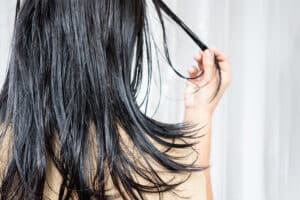
Understanding Fine Hair: A Brief Overview
Fine hair is characterized by its small diameter and lightweight texture. While fine hair can be smooth and silky, it is also more prone to greasiness due to its thinner strands and smaller follicles. Unlike coarse or thick hair, which can better distribute natural oils (sebum) along the hair shaft, fine hair struggles to do so, leading to a buildup of oil on the scalp and roots.
The Science Behind Greasy Hair: Exploring Sebum Production
Sebum, produced by the sebaceous glands in the scalp, is essential for maintaining healthy hair and skin. However, excessive sebum production can result in greasy hair. In individuals with fine hair, the sebaceous glands may produce more oil than necessary, leading to a greasy appearance shortly after washing.
Factors Contributing to Greasiness in Fine Hair
Several factors can contribute to greasiness in fine hair:
- Genetics: Genetic predisposition plays a significant role in determining sebum production and hair texture.
- Hormonal Changes: Hormonal fluctuations, such as those experienced during puberty, menstruation, pregnancy, or menopause, can affect sebum production and exacerbate greasiness.
- Overwashing: Washing fine hair too frequently can strip away natural oils, prompting the scalp to produce more oil to compensate, resulting in greasiness.
- Incorrect Hair Care Products: Using heavy or oily hair care products can weigh down fine hair and contribute to greasiness.
- Environmental Factors: Humidity and pollution can exacerbate greasiness by attracting dirt and oil to the hair.
Common Misconceptions About Fine Hair and Greasiness
Despite its delicate appearance, fine hair is not necessarily fragile. In fact, fine hair can be resilient and versatile when properly cared for. Additionally, while it may seem counterintuitive, overwashing fine hair can actually worsen greasiness by stimulating the scalp to produce more oil. Finding the right balance of cleansing and moisturizing is key to managing greasiness effectively.
Tips for Managing Greasy Fine Hair: Dos and Don’ts
Do:
- Wash hair regularly with a gentle, clarifying shampoo designed for oily hair.
- Use lightweight, oil-free hair care products specifically formulated for fine hair.
- Incorporate dry shampoo into your routine to absorb excess oil between washes.
- Experiment with different hairstyles to minimize contact between the scalp and hair.
Don’t:
- Overwash your hair, as this can strip away natural oils and exacerbate greasiness.
- Use heavy or greasy hair care products that can weigh down fine hair and make it appear greasier.
- Touch your hair excessively throughout the day, as this can transfer oils from your hands to your hair.
Choosing the Right Hair Care Products for Fine, Greasy Hair
When selecting hair care products for fine, greasy hair, opt for lightweight formulas that won’t weigh down your locks. Look for shampoos and conditioners labeled as “clarifying” or “oil-free,” as these are specifically designed to remove excess oil and buildup without stripping the hair of its natural moisture. Additionally, consider incorporating a weekly clarifying treatment or scalp scrub to deeply cleanse the scalp and remove impurities.
Professional Treatments and Techniques for Greasy Fine Hair
In addition to at-home care, professional treatments and techniques can help manage greasiness in fine hair. Consider scheduling regular scalp treatments or deep-cleansing facials at your local salon to remove buildup and rebalance the scalp’s oil production. Additionally, consult with your stylist about the best haircut and styling techniques to maximize volume and minimize greasiness.
Lifestyle Adjustments to Combat Greasiness in Fine Hair
Making simple lifestyle adjustments can also help combat greasiness in fine hair. Avoid touching your hair unnecessarily, as this can transfer oils from your hands to your locks. Additionally, aim to maintain a healthy diet rich in vitamins and nutrients that promote scalp health, such as omega-3 fatty acids, vitamin E, and biotin.
Embracing and Styling Fine Hair: Confidence Tips
Despite its challenges, fine hair can be incredibly versatile and beautiful when styled with confidence. Embrace your natural texture and experiment with different hairstyles and products to find what works best for you. Remember that greasiness is a common issue that many individuals with fine hair face, and with the right care and maintenance, you can achieve healthy, voluminous locks that you’ll love.
In conclusion, understanding the factors contributing to greasiness in fine hair and implementing practical tips and techniques can help you manage this common concern effectively. By choosing the right hair care products, incorporating professional treatments, making lifestyle adjustments, and embracing your natural texture, you can achieve healthy, vibrant hair that looks and feels amazing.
Please book an appointment and talk about this with a hair care professional near you.
